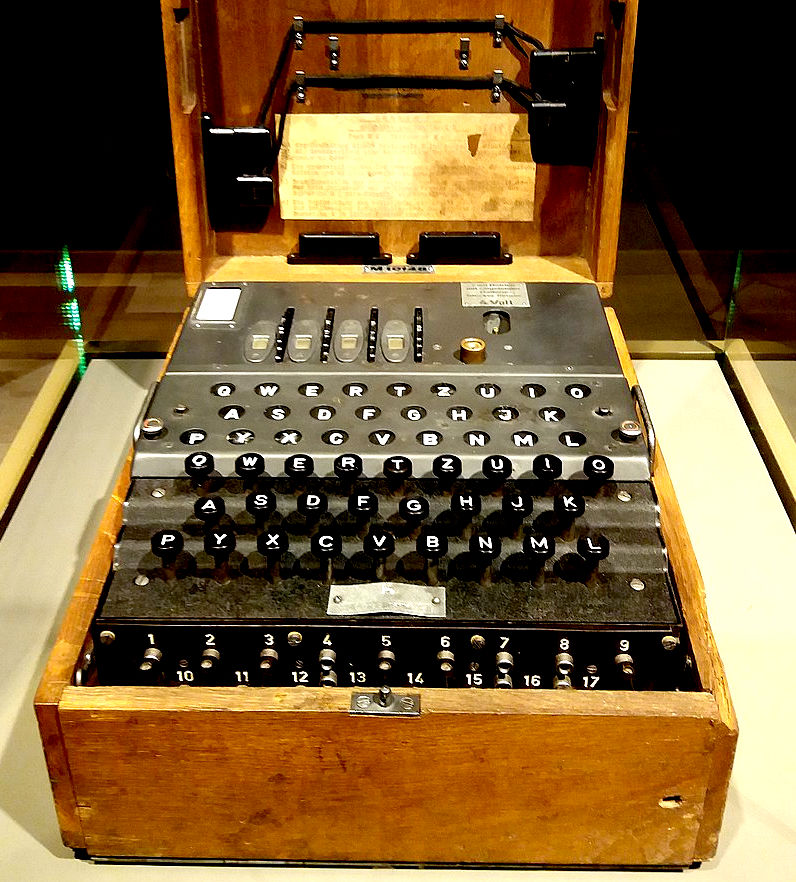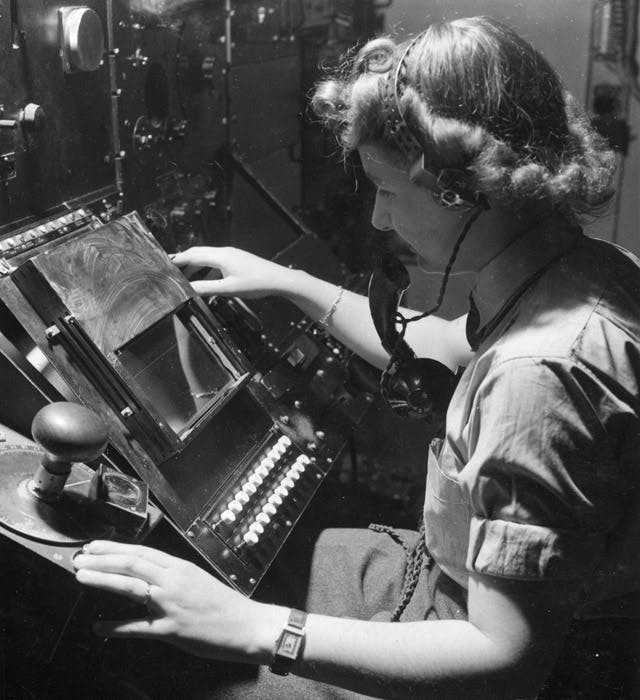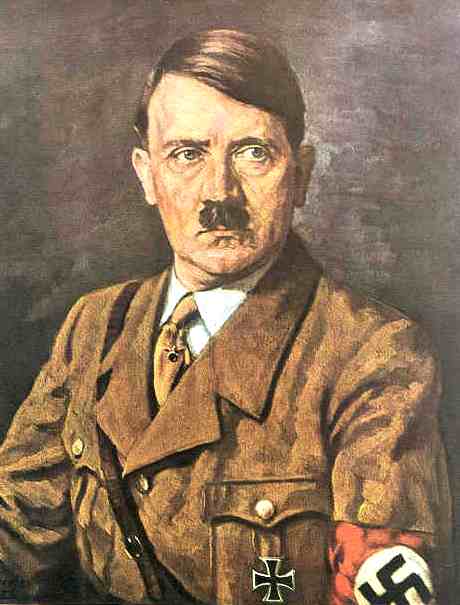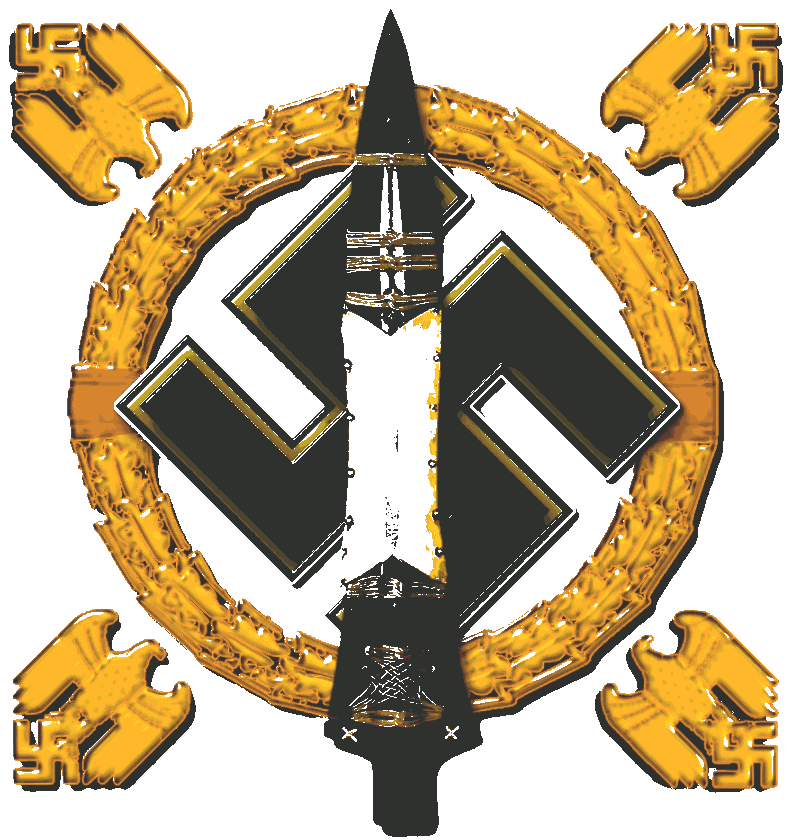
During
the Second World War, Nazi Germany used coded messages electrically and
mechanically scrambled by an Enigma machine,
The Enigma machine is a cipher device developed and used in the
early - to middle of the 20th century to protect commercial, diplomatic, and military
communications. It was employed extensively by Nazi Germany during World War II, in all branches of the German military. The Enigma machine was considered so secure that it was used to encipher the most top-secret messages.
The Enigma has an electromechanical rotor mechanism that scrambles the 26 letters of the alphabet. In typical use, one person enters text on the Enigma's keyboard and another person writes down which of the 26 lights above the keyboard illuminated at each key press. If plain text is entered, the illuminated letters are the encoded ciphertext. Entering ciphertext transforms it back into readable plaintext. The rotor mechanism changes the electrical connections between the keys and the lights with each keypress.
The security of the system depends on machine settings that were generally changed daily, based on secret key lists distributed in advance, and on other settings that were changed for each message. The receiving station would have to know and use the exact settings employed by the transmitting station to successfully decrypt a message.
While Nazi Germany introduced a series of improvements to the Enigma over the years, and these hampered decryption efforts, they did not prevent Poland from cracking the machine prior to the war, enabling the Allies to exploit Enigma-enciphered messages as a major source of intelligence. Many commentators say the flow of Ultra communications intelligence from the decryption of Enigma, Lorenz, and other ciphers, shortened the war substantially, and might even have altered its outcome.
INVENTION
The Enigma machine was invented by German engineer Arthur Scherbius at the end of World War I. This was unknown until 2003 when a paper by Karl de Leeuw was found that described in detail Scherbius' changes. The German firm Scherbius & Ritter, co-founded by Scherbius, patented ideas for a cipher machine in 1918 and began marketing the finished product under the brand name Enigma in 1923, initially targeted at commercial markets. Early models were used commercially from the early 1920s, and adopted by military and government services of several countries, most notably Nazi Germany before and during World War II.
Several different Enigma models were produced, but the German military models, having a plugboard, were the most complex. Japanese and Italian models were also in use. With its adoption (in slightly modified form) by the German Navy in 1926 and the German Army and Air Force soon after, the name Enigma became widely known in military circles. Pre-war German military planning emphasized fast, mobile forces and tactics, later known as blitzkrieg, which depend on radio communication for command and coordination. Since adversaries would likely intercept radio signals, messages had to be protected with secure encipherment. Compact and easily portable, the Enigma machine filled that need.
BREAKING THE CODE
Around December 1932 Marian Rejewski, a Polish mathematician and cryptologist at the Polish Cipher Bureau, used the theory of permutations, and flaws in the German military-message encipherment procedures, to break message keys of the plugboard Enigma machine. France's spy Hans-Thilo Schmidt obtained access to German cipher materials that included the daily keys used in September and October 1932. Those keys included the plugboard settings. The French passed the material to the Poles, and Rejewski used some of that material and the message traffic in September and October to solve for the unknown rotor wiring. Consequently the Polish mathematicians were able to build their own Enigma machines, dubbed "Enigma doubles". Rejewski was aided by fellow mathematician-cryptologists Jerzy Różycki and Henryk Zygalski, both of whom had been recruited with Rejewski from Poznań University, which had been selected for its students' knowledge of the German language, since that area was held by Germany prior to World War I. The Polish Cipher Bureau developed techniques to defeat the plugboard and find all components of the daily key, which enabled the Cipher Bureau to read German Enigma messages starting from January 1933.
Over time, the German cryptographic procedures improved, and the Cipher Bureau developed techniques and designed mechanical devices to continue reading Enigma traffic. As part of that effort, the Poles exploited quirks of the rotors, compiled catalogues, built a cyclometer (invented by Rejewski) to help make a catalogue with 100,000 entries, invented and produced Zygalski sheets, and built the electromechanical cryptologic bomba (invented by Rejewski) to search for rotor settings. In 1938 the Poles had six bomby (plural of bomba), but when that year the Germans added two more rotors, ten times as many bomby would have been needed to read the traffic.
On 26 and 27 July 1939, in Pyry, just south of Warsaw, the Poles initiated French and British military intelligence representatives into the Polish Enigma-decryption techniques and equipment, including Zygalski sheets and the cryptologic bomb, and promised each delegation a Polish-reconstructed Enigma (the devices were soon delivered).
In September 1939, British Military Mission 4, which included Colin Gubbins and Vera Atkins, went to Poland, intending to evacuate cipher-breakers Marian Rejewski, Jerzy Różycki, and Henryk Zygalski from the country. The cryptologists, however, had been evacuated by their own superiors into Romania, at the time a Polish-allied country. On the way, for security reasons, the Polish Cipher Bureau personnel had deliberately destroyed their records and equipment. From Romania they traveled on to France, where they resumed their cryptological work, collaborating by teletype with the British, who began work on decrypting German Enigma messages, using the Polish equipment and techniques.
Gordon Welchman, who became head of Hut 6 at Bletchley Park, has written: "Hut 6 Ultra would never have gotten off the ground if we had not learned from the Poles, in the nick of time, the details both of the German military version of the commercial Enigma machine, and of the operating procedures that were in use." The Polish transfer of theory and technology at Pyry formed the crucial basis for the subsequent
World War II British Enigma-decryption effort at Bletchley Park, where Welchman worked.
During the war, British cryptologists decrypted a vast number of messages enciphered on Enigma. The intelligence gleaned from this source, codenamed "Ultra" by the British, was a substantial aid to the Allied war effort.
Though Enigma had some cryptographic weaknesses, in practice it was German procedural flaws, operator mistakes, failure to systematically introduce changes in encipherment procedures, and Allied capture of key tables and hardware that, during the war, enabled Allied cryptologists to succeed.
With super computers today, the Enigma machines would not have stood a chance, but improved electronic scrambling, increases the complexity of the decoding challenge. The Nanocomm supercomputer cracks all known codes in seconds. But, should agencies obtain that technology, the race would be on to invent ever more complex cryptographic solutions.
COMPUTERS
From the machine that we used to write this article, to the incredible processing power of an
ordinary smart phone, modern computing would not be what it is without the innovation of the Government Code and Cipher School at Bletchley Park and Colossus. This giant installation used glass valves, because transistors would not be invented until NASA wanted a computer light enough to go to the Moon.
Originally invented as a way to speed up the cracking of the German Enigma codes, Colossus was the first of many computers which have gradually shrunk in size to become part of everyday life, with their use in work, schools and play around the world.
In our Cleopatra
story, super computers are used by the Nazi Occultists to genetically modify
their superhuman genomes, and to generate bioploymer 3D printed body
structures, to grow replicated humans in the RepliVator,
invented by Franco
Francisco.

RADAR -
Perfected by the British during the Battle of Britain to detect incoming air raids, radar is still used in everyday life.
A
- Z OF NAZI GERMANY

Der
Fuhrer, Adolf Hitler, started WWII
|



